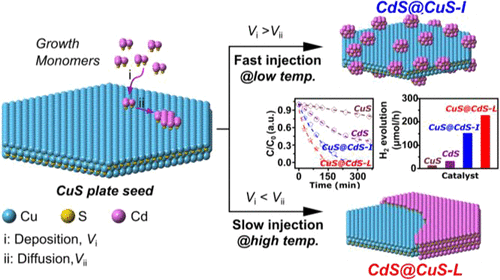当前位置:
X-MOL 学术
›
ACS Sustain. Chem. Eng.
›
论文详情
Our official English website, www.x-mol.net, welcomes your
feedback! (Note: you will need to create a separate account there.)
Controlling the Core–Shell Structure of [email protected] Heterojunction via Seeded Growth with Tunable Photocatalytic Activity
ACS Sustainable Chemistry & Engineering ( IF 7.1 ) Pub Date : 2018-10-16 00:00:00 , DOI: 10.1021/acssuschemeng.8b04606 Naixu Li 1 , Wenlong Fu 2 , Chen Chen 3 , Maochang Liu 2, 4 , Fei Xue 2 , Quanhao Shen 1 , Jiancheng Zhou 1
ACS Sustainable Chemistry & Engineering ( IF 7.1 ) Pub Date : 2018-10-16 00:00:00 , DOI: 10.1021/acssuschemeng.8b04606 Naixu Li 1 , Wenlong Fu 2 , Chen Chen 3 , Maochang Liu 2, 4 , Fei Xue 2 , Quanhao Shen 1 , Jiancheng Zhou 1
Affiliation

|
We report the seed-mediated synthesis of [email protected] core–shell heterojunction with diverse morphologies by introducing kinetic control. By using CuS nanoplates as seeds and a collective manipulation of the injection rate of Cd2+ precursor with a syringe pump and the reaction temperature, two distinctive growth modes, i.e., island and layer-by-layer modes, respectively, could be realized. It is found that the growth is, in principle, determined by the deposition rate relative to the diffusion rate of the CdS growth monomers. Specifically, at a high injection rate and a relatively low reaction temperature, the deposition of CdS monomers on the surface of the CuS nanoplate follows an island growth mode because of the lattice mismatch between CuS and CdS and distinct binding energies of them. We can facilitate surface diffusion of these deposited monomers by reducing the injection rate of Cd2+ and increasing the reaction temperature. In this case, growth can be switched to a layer-by-layer mode. The products are found with tunable and significantly improved photocatalytic performance toward dye degradation and H2 production from water under visible-light irradiation in comparison to the sole use of either CdS or CuS photocatalyst. This work provides an effective approach to the rational design of heterojunctions.
中文翻译:

通过具有可调光催化活性的种子生长控制[受电子邮件保护的]异质结的核-壳结构
通过引入动力学控制,我们报道了种子介导的[电子邮件保护的]核-壳异质结的合成,具有多种形态。通过使用CuS纳米板作为种子并共同控制Cd 2+的注入速率用注射泵的前驱体和反应温度,可以实现两种不同的生长模式,即分别为岛型和逐层模式。已经发现,生长基本上是由相对于CdS生长单体的扩散速率的沉积速率决定的。具体地,在高注入速率和相对低的反应温度下,由于CuS和CdS之间的晶格失配以及它们的独特的结合能,CdS单体在CuS纳米板的表面上的沉积遵循岛生长模式。我们可以通过降低Cd 2+的注入速率来促进这些沉积单体的表面扩散并提高反应温度。在这种情况下,可以将生长切换到逐层模式。与仅使用CdS或CuS光催化剂相比,发现该产品对可见光照射下的染料降解和水中H 2的产生具有可调的和显着改善的光催化性能。这项工作为合理设计异质结提供了一种有效的方法。
更新日期:2018-10-16
中文翻译:

通过具有可调光催化活性的种子生长控制[受电子邮件保护的]异质结的核-壳结构
通过引入动力学控制,我们报道了种子介导的[电子邮件保护的]核-壳异质结的合成,具有多种形态。通过使用CuS纳米板作为种子并共同控制Cd 2+的注入速率用注射泵的前驱体和反应温度,可以实现两种不同的生长模式,即分别为岛型和逐层模式。已经发现,生长基本上是由相对于CdS生长单体的扩散速率的沉积速率决定的。具体地,在高注入速率和相对低的反应温度下,由于CuS和CdS之间的晶格失配以及它们的独特的结合能,CdS单体在CuS纳米板的表面上的沉积遵循岛生长模式。我们可以通过降低Cd 2+的注入速率来促进这些沉积单体的表面扩散并提高反应温度。在这种情况下,可以将生长切换到逐层模式。与仅使用CdS或CuS光催化剂相比,发现该产品对可见光照射下的染料降解和水中H 2的产生具有可调的和显着改善的光催化性能。这项工作为合理设计异质结提供了一种有效的方法。











































 京公网安备 11010802027423号
京公网安备 11010802027423号